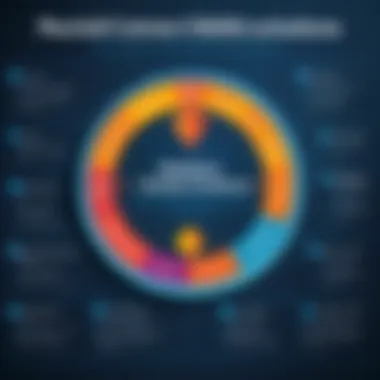Gartner's Magic Quadrant for CMMS: A Comprehensive Analysis


Intro
In the landscape of modern business operations, Computerized Maintenance Management Systems (CMMS) have become essential for ensuring optimal performance of assets and maintenance processes. As organizations seek solutions to improve operational efficiency, the Gartner Magic Quadrant serves as a significant tool for evaluating the vast array of CMMS offerings. The report offers a visual representation of a market's direction, maturity, and participants.
This article delves into the nuances of Gartner's Magic Quadrant for CMMS. It aims to equip decision-makers, IT professionals, and entrepreneurs with the knowledge needed to navigate the complex world of CMMS solutions. The discussion will center on evaluating the criteria utilized in the rankings, the implications of these rankings on purchasing decisions, and a closer look at the top vendors identified in the latest Gartner report.
Understanding the significance of the Magic Quadrant assists in forming strategies around procurement and vendor selection. Recognizing how each vendor is positioned can impact investment decisions and ultimately influence an organization's maintenance strategy. With this foundation, we will explore the key features, functionalities, and impactful insights derived from Gartner's analysis of CMMS solutions.
Understanding the Gartner Magic Quadrant
The Gartner Magic Quadrant is a crucial tool for organizations seeking to assess their options when it comes to selecting technology vendors. This section aims to unravel the significance of the Magic Quadrant, specifically within the context of Computerized Maintenance Management Systems (CMMS). Utilizing this framework can help decision-makers understand market dynamics, identify leading solutions, and make informed choices tailored to their organizational needs.
Definition and Purpose
The Gartner Magic Quadrant serves as a visual representation, breaking down the competitive landscape of technology solutions into four distinct quadrants: Leaders, Challengers, Visionaries, and Niche Players. Each quadrant relates to the vendor’s overall performance and their ability to realize their vision effectively. For CMMS, this evaluation is pivotal. It simplifies the complex process of comparing multiple vendors and reduces risk during the buying process.
The purpose of the Magic Quadrant goes beyond mere ranking. It evaluates companies based on two primary criteria: completeness of vision and ability to execute. This dual assessment informs stakeholders about both the strategic direction of solutions and the vendor’s capacity to deliver.
Historical Context
Gartner, founded in 1979, has long been a respected authority in the realm of technology research and advisory. The Magic Quadrant was introduced in the 1990s as a response to the need for an objective, analytical framework for assessing the technology market. Over the years, it has evolved, continuously adapting to shifts in technology and market demands.
Initially focused on broader technology segments, the Magic Quadrant now encompasses niche categories, including CMMS. Businesses have increasingly relied on these insights to navigate their purchasing decisions, especially as the complexity of technology solutions has grown. The historical evolution of the Magic Quadrant reflects not only the advancement in technology but also the increasing need for clear, concise data to aid business decisions.
Through its detailed analysis, the Gartner Magic Quadrant has become an industry benchmark, influencing how organizations prioritize their investments in technology and emphasizing the importance of informed decision-making.
The Importance of CMMS in Modern Businesses
In today’s competitive landscape, organizations are increasingly reliant on efficient operational frameworks to enhance productivity and reduce costs. One way this is achieved is through Computerized Maintenance Management Systems (CMMS). These systems play a critical role in modern businesses by optimizing maintenance operations, extending equipment lifespan, and ultimately contributing to bottom-line savings. By automating and simplifying maintenance practices, CMMS enables organizations to not only maintain their assets but also to respond swiftly to changing demands in their respective sectors.
Defining CMMS
Computerized Maintenance Management System, or CMMS, is a software solution that streamlines maintenance management. It assists organizations in scheduling, tracking, and managing maintenance activities efficiently. It often consolidates information related to maintenance tasks, assets, and work orders into a central repository. This allows for better organization and prioritization of maintenance efforts. In essence, CMMS serves as a foundational element for effective asset management, aiding in compliance and reducing downtime.
A typical CMMS offers features such as:
- Work order creation and management
- Asset tracking and management
- Preventive maintenance scheduling
- Inventory management for spare parts
- Reporting and analytics for performance assessment
Benefits of Implementing CMMS
Implementing a CMMS can provide various advantages that significantly impact an organization’s operations. Some key benefits include:
- Increased Equipment Lifespan: By taking a proactive approach to maintenance, CMMS helps extend the life expectancy of critical assets, reducing the frequency of costly replacements.
- Improved Efficiency: Automated scheduling and task management enable teams to concentrate on high-priority tasks without the burden of manual tracking.
- Cost Reduction: Effective maintenance management can lower both labor and inventory costs through reduced downtime and optimized resource allocation.
- Enhanced Compliance: Many industries have strict regulations regarding equipment maintenance. A CMMS helps ensure compliance through accurate record-keeping and reporting.
- Data-Driven Decisions: CMMS collects and analyzes data that can inform strategic decision-making and long-term planning.
"A robust CMMS offers the framework necessary for businesses to transform maintenance from a reactive, costly function into a strategic asset"
Criteria for Evaluation in Gartner's Magic Quadrant
Understanding the criteria for evaluation in Gartner's Magic Quadrant is crucial for those engaged in the selection of Computerized Maintenance Management Systems (CMMS). This framework not only serves as a robust tool for identifying suitable vendors but also aids decision-makers in judging the competitive landscape. Evaluating CMMS platforms through the lens of this quadrant allows buyers to assess various aspects that include strategic direction, capability to deliver, and overall recognition in the market.
Completeness of Vision
Completeness of vision involves analyzing how well a vendor’s strategy aligns with market trends and customer demands. This aspect encompasses several elements:


- Innovation: A vendor's ability to introduce new features and improve existing functionalities is a hallmark. Looking at how they adapt their offerings in response to emerging technologies, like IoT and AI, is vital for potential buyers.
- Market Understanding: Vendors should demonstrate a clear understanding of the needs within the CMMS market. Their vision should reflect an awareness of the challenges faced by businesses in maintaining assets effectively.
- Product Strategy: The degree to which the product roadmap is articulated and actionable also matters. A clear vision for future development can indicate the long-term viability of the solution.
A strong completeness of vision often correlates with sustained growth and user satisfaction, making it a key factor for assessment.
Ability to Execute
Ability to execute describes how effectively a vendor can deliver its offerings, which includes both product performance and operational efficiency. This can be broken down into:
- Product Quality: The robustness and reliability of the CMMS solution are paramount. Metrics such as downtime and system stability play a significant role in this assessment.
- Sales and Pricing: How well a vendor’s pricing strategy corresponds to market expectations can impact their ability to gain traction among buyers. Competitive pricing combined with strong value propositions is attractive.
- Customer Service and Support: Efficient customer service is critical for users. The speed and effectiveness of support can influence user experience and satisfaction long after the sale has been made.
The ability to execute often impacts overall ratings in the Magic Quadrant, as consistent performance can draw repeat customers.
Market Recognition and User Feedback
This criterion underscores the importance of external validation. Market recognition reflects how vendors are perceived in the industry and the feedback gathered from users. This involves:
- Brand Reputation: Recognition in industry publications and awards can elevate a vendor's standing. A strong brand can instill confidence in potential customers.
- User Reviews: Actual user experiences provide meaningful insights. Feedback often reveals strengths and weaknesses that may not be evident through formal evaluations.
- Client Base: The diversity and size of a vendor’s client base can also be a telling sign of their market impact. A wide array of successful implementations across different sectors can heighten credibility.
Ultimately, market recognition and user feedback can steer decision-makers towards vendors known for quality, reliability, and customer satisfaction.
"Understanding the criteria for evaluation in Gartner's Magic Quadrant not only empowers decision-makers but also ensures that organizations invest in systems that align with their strategic objectives."
Key Players in the CMMS Market
The competitive landscape of Computerized Maintenance Management Systems (CMMS) is crucial for various reasons. For decision-makers and IT professionals, understanding key players helps in informed decision-making regarding software implementations. The effectiveness and usability of CMMS platforms can significantly impact maintenance strategies in organizations. Each quadrant of the Magic Quadrant showcases solutions that meet distinct criteria, making it imperative to recognize the sector's leading companies.
Leader Quadrant
The Leader Quadrant includes the most prominent players in the CMMS market. These organizations stand out for their strong performance across multiple metrics in Gartner’s evaluation. Companies here demonstrate a solid ability to execute, along with a clear completeness of vision. Notable leaders consistently receive positive feedback from users for their product reliability and robust features.
Implementing solutions from the Leader Quadrant provides several benefits:
- Comprehensive Functionality: These solutions often have advanced features, including predictive maintenance, real-time reporting, and user-friendly interfaces.
- Strong Support and Resources: Leaders typically offer excellent customer support and extensive resources for training and implementation.
- High User Satisfaction: User reviews highlight these platforms' ability to improve maintenance operations significantly.
This makes the Leader Quadrant appealing for organizations that seek a tested and reliable solution, minimizing risks associated with implementation.
Challenger Quadrant
The Challenger Quadrant describes companies that have a good capacity to execute but may lack a fully developed vision compared to leaders. While they may not innovate as quickly, they often maintain a strong market presence.
These companies usually focus on integrating customer demands and refining existing products rather than exploring entirely new technologies. The key aspects of Challenger Quadrant players include:
- Cost-Effectiveness: Organizations can find solutions that are budget-friendly but still offer essential functionalities.
- Customization Options: Many challengers provide customization possibilities that allow businesses to shape the CMMS to their specific needs.
Challengers can be suitable choices for organizations that seek dependable solutions without the premium price tags typically associated with leaders.
Visionary Quadrant
Visionary Quadrant firms are recognized for their innovative approaches and foresight in CMMS functionalities. These companies focus on the future of maintenance management and often introduce new features that challenge traditional methods.
Key characteristics of players in the Visionary Quadrant include:
- Innovative Features: Companies in this quadrant often emphasize technological advancements, including IoT integrations and AI-driven analytics.
- Future-Oriented Solutions: They provide tools aimed at addressing future maintenance needs, adapting to emerging industry trends.
Choosing from the Visionary Quadrant is advisable for organizationds aiming to stay ahead in technology adoption.


Niche Player Quadrant
The Niche Player Quadrant consists of companies that specialize in specific aspects of CMMS or market segments. These players may focus on unique industries or contain specialized features that suit certain operational requirements.
The strengths of niche players include:
- Specialized Functionality: They often deliver highly tailored solutions that serve particular industries or operational needs.
- Focused Marketing Strategies: They identify distinct customer gaps and design their products to address them effectively.
Organizations seeking distinctive features for specific operational needs might find the best fit in the Niche Player Quadrant, maximizing their chances for a tailored solution.
Understanding each quadrant within the CMMS market landscape enables decision-makers to choose suitable solutions tailored to their unique needs, ensuring more successful implementations and sustainable operations.
Analysis of the Latest CMMS Magic Quadrant
The Analysis of the Latest CMMS Magic Quadrant holds significant importance in understanding how various Computerized Maintenance Management Systems are evaluated and compared. It provides a structured framework that allows decision-makers to discern the strengths and weaknesses of the leading solutions in the market. This analysis empowers organizations to make informed choices regarding investment in CMMS technologies that align with their operational goals. As industries evolve, keeping abreast of these evaluations becomes increasingly critical.
Overview of Findings
In the latest report from Gartner, several key findings emerge that illustrate the current landscape of the CMMS market. The evaluation highlights a distinct shift towards cloud-based solutions, which allow streamlined operations and enhanced accessibility. In addition, vendors are increasingly focusing on user experience and integration capabilities. These findings indicate a growing demand for systems that not only protect company assets but also facilitate collaboration among departments.
Some notable observations from the report include:
- A rise in subscription-based models that lower entry costs.
- Greater emphasis on predictive maintenance features, adhering to industry standards.
- Security measures that enhance data protection for sensitive organizational information.
Furthermore, the analysis emphasizes the importance of scalability in CMMS solutions. Companies are looking for systems that can evolve alongside their business needs.
"The ability of a CMMS to integrate with existing software solutions is a key determinant in purchasing decisions for many organizations."
Comparison of Top Vendors
The comparison of top vendors in the latest CMMS Magic Quadrant reveals critical insights for potential buyers. Each vendor is assessed based on completeness of vision and ability to execute, distinguishing them within their respective quadrants—Leader, Challenger, Visionary, and Niche Player.
- Leaders: Typically offer robust solutions with comprehensive functionalities. They demonstrate stability and a proven track record within the industry. Key players often seen in this quadrant include IBM Maximo and Infor EAM.
- Challengers: These vendors show strong performance but may lack in certain areas compared to leaders. They often focus on improving product offerings. Noteworthy mentions include Dude Solutions and FMX.
- Visionaries: They often introduce innovative approaches and features, such as advanced analytics and mobile capabilities. However, they might not fully execute all aspects of their vision. Companies like UpKeep can be found here.
- Niche Players: These vendors may serve specific markets or focus areas but may lack the broad appeal or capabilities of others. Examples include Hippo CMMS and Maintenance Connection.
Implications for Buyers and Decision-Makers
Understanding the implications of the Gartner Magic Quadrant is crucial for buyers and decision-makers within organizations. This matrix not only categorizes CMMS solutions but provides a framework to evaluate the strengths and weaknesses of different vendors. By referencing this widely recognized analysis, decision-makers can reduce risks associated with software selection. They can choose a solution that aligns with their specific needs and operational contexts.
One of the main benefits of utilizing the Magic Quadrant is the clarity it offers in terms of vendor capabilities. Each quadrant highlights how well vendors can execute their strategies as well as how complete their vision for the market is. This information is vital when weighing options, especially in sectors where maintenance strategies are directly tied to operational efficiency.
When making a selection, understanding the market trends reflected in the Magic Quadrant is just as important as the data about individual vendors. For instance, the growing emphasis on advanced analytics and IoT capabilities is increasingly shaping CMMS developments. By recognizing these trends, buyers can position themselves strategically to leverage technological advancements.
Potential buyers also benefit from the user feedback integrated into the evaluation. This feedback, often derived from real-world experiences, sheds light on how the solutions work in practice. Buyers should consider this feedback for more informed decision-making. As such, evaluating user experiences becomes an essential part of the process, as it can highlight potential challenges.
"Gartner's Magic Quadrant serves as both a guide and a warning for businesses navigating their software selections."
Another implication is the aid in budget considerations during the selection process. The Magic Quadrant enables stakeholders to compare solutions based on expected performance and capabilities relative to cost. This is crucial because higher-rated solutions might be appealing, but they also come at a premium. Buyers must balance their organizational needs against budget constraints to make the most informed choices.
Navigating Choices in CMMS Solutions
The choices available in the CMMS landscape are extensive. When evaluating potential solutions, decision-makers must navigate a variety of elements that come into play. One critical aspect is how well solutions align with an organization’s operational workflow.
An effective CMMS should facilitate daily tasks and provide noteworthy efficiencies. Buyers should look for systems that offer customizable features and configurable dashboards that reflect their operational requirements.


Another key consideration is scalability. Organizations may start with basic maintenance needs but grow over time. Choosing a CMMS that can scale along with the organization is vital. This prevents frequent vendor changes, which can be disruptive and costly.
Moreover, integration capabilities should be assessed. Many organizations utilize various software systems. A CMMS that can seamlessly integrate with other tools will provide more value and operational synergy. Decision-makers should inquire about API availability and integration partnerships.
Finally, evaluating customer support services is paramount. A responsive support team can significantly impact the implementation and ongoing use of the CMMS. Buyers should assess support structures available and perhaps even verify by speaking to current users.
Assessing Organizational Needs
To make an informed decision in choosing a CMMS, one must start with a thorough understanding of the organization’s needs. Conducting a detailed assessment of current processes, maintenance strategies, and desired outcomes is essential.
First, organizations should identify specific aspects of maintenance they wish to improve. This could span preventive maintenance schedules, work order management efficiency, or reporting capabilities. Recognizing these areas of focus will allow buyers to align them with features offered by potential CMMS candidates.
Next, evaluating the resources at hand becomes critical. It is not just about technology; it also includes the workforce capable of utilizing these systems effectively. Assessing the skill levels of existing staff will guide buyers toward systems that are user-friendly and require minimal training.
Additionally, management buy-in is crucial. Ensuring that key stakeholders understand and support the direction can influence the eventual success of a CMMS implementation. Decision-makers should communicate the broader benefits of adopting a CMMS to garner support across various levels of the organization.
Lastly, it is essential to define success metrics before selecting a solution. Establishing how success will be measured helps set clear expectations. It will also guide future evaluations of the implemented CMMS against objectives.
Future Trends in CMMS
As organizations strive for increased efficiency and effectiveness, the relevance of understanding future trends in Computerized Maintenance Management Systems (CMMS) cannot be overstated. CMMS solutions are evolving, adapting to technological advancements and changing market demands. Identifying these trends helps decision-makers formulate strategies that align with both current and future operational needs. This understanding is essential for making informed investments in maintenance management technology, ensuring that systems implement capabilities that remain relevant in the coming years.
Technological Innovations
The landscape of CMMS is increasingly shaped by rapid technological innovations. These advancements not only enhance existing features but also introduce new functionalities that improve user experience and operational efficiency. Cloud computing is one prominent innovation. It allows organizations to access their CMMS from anywhere, facilitating real-time data analysis and decision-making.
Moreover, the rise of mobile applications empowers technicians by providing them access to maintenance tasks right at their fingertips. This results in quicker responses to issues and improved communication among team members. Another significant trend is the integration of Internet of Things (IoT) technology. Devices connected through IoT can transmit data directly to a CMMS, offering insights into equipment performance and predicting maintenance needs well in advance.
Data analytics is a critical element as well. Enhanced analytics tools enable organizations to analyze maintenance history, equipment performance, and resource utilization, leading to data-driven decision-making.
"Technological innovation in CMMS is not just about keeping up; it is about staying ahead of the curve to optimize maintenance operations and reduce downtime."
Growing Importance of Integration
The importance of integration in CMMS systems continues to grow. Seamless integration with other enterprise software solutions, such as Enterprise Resource Planning (ERP) systems and Customer Relationship Management (CRM) tools, enables organizations to centralize their processes. This can lead to improved visibility across departments, reducing silos that traditionally impede effective maintenance management.
Furthermore, forging integration with supply chain management platforms enhances the procurement process for maintenance supplies and parts. This interconnectedness facilitates better forecasting and inventory management. Data synchronization across systems also ensures that personnel are always working with the most current information, leading to more informed decisions.
Another consideration involves integrating Artificial Intelligence (AI) and Machine Learning (ML). These technologies can analyze vast amounts of data to identify patterns that human operators may overlook, further optimizing maintenance schedules and improving resource allocation.
In summary, keeping an eye on technological innovations and integration capabilities will position organizations to leverage CMMS effectively. By anticipating these future trends, businesses can refine their strategies and investment decisions.
Ending and Key Takeaways
The conclusion serves a crucial role in synthesizing the insights presented throughout the article. It brings clarity to the complex discussions surrounding the Gartner Magic Quadrant for CMMS, reinforcing its significance in the decision-making process for various stakeholders. Here, we summarize the key findings and offer final thoughts for those navigating the intricate landscape of computerized maintenance management systems.
Summarizing Insights
In reviewing the various sections, several insights emerge that highlight the essence of Gartner's Magic Quadrant for CMMS:
- Importance of Evaluation Criteria: The metrics used for evaluating CMMS solutions reveal much about their capacity to meet organizational needs. The Completeness of Vision and Ability to Execute are pivotal in understanding how these tools can support maintenance operations.
- Vendor Insights: The positioning of vendors in the Magic Quadrant gives buyers a strategic perspective regarding market leaders and emerging players. Understanding the ranking impacts vendor selection and ultimately affects maintenance efficiency within organizations.
- Future Trends: The analysis of trends illustrates the dynamic nature of the CMMS market. Technological innovations and integration capabilities are not just optional features anymore; they are essential for competitive advantage and operational success.
The quality of CMMS solutions directly impacts maintenance operations, operational efficiency, and cost reduction within organizations.
Final Recommendations
Based on the examination of the Gartner Magic Quadrant, here are several recommendations for decision-makers and IT professionals:
- Engage with Vendors: Participate in demos and trials of CMMS solutions. Understanding the software through firsthand experience helps cement choices based on usability and functionality.
- Prioritize Needs Assessment: Carefully assess organizational needs against the capabilities of each CMMS solution. Identify which features are critical and choose software that aligns closely with these needs.
- Stay Informed on Trends: Regularly monitor emerging technologies and integration capabilities in the CMMS sector. This knowledge can help organizations remain agile and responsive to changing business environments.
- Seek Feedback: Leverage user feedback and market recognition. Engaging with the community can provide valuable insights into the effectiveness and reliability of specific solutions.
These recommendations will assist in making informed decisions while navigating through the complexities of CMMS solutions, ensuring alignment with both current and future organizational goals.















